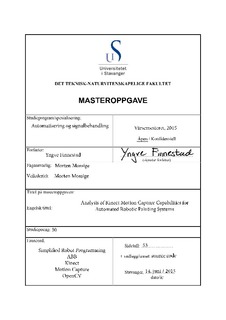| dc.contributor.author | Finnestad, Yngve | |
| dc.date.accessioned | 2015-09-08T13:55:20Z | |
| dc.date.available | 2015-09-08T13:55:20Z | |
| dc.date.issued | 2015-06-15 | |
| dc.identifier.uri | http://hdl.handle.net/11250/299116 | |
| dc.description | Master's thesis in Automation and signal processing | nb_NO |
| dc.description.abstract | The focus of this project is to determine the motion capture capabilities of the Kinect sensor. Motion capture is the process of recording human movement, and converting the captured data into a virtual environment. A simple implementation of motion capture is currently used by ABB for their Simplified Robot Programming project.
Simplified Robot Programming allows the painter to program a robot by demonstrating the desired movement, instead of programming it.
To simplify the programming of paths for robotic paint applications, the movements of a professional painter are recorded and translated into a corresponding path in virtual space. The programmer will no longer have to manually program the coordinates in a path for the robot to follow, as it will follow the motion of the painter. This is currently done by a magnetic motion capture system.
This project will ideally determine if the Microsoft Kinect v2 sensor can serve as a more cost efficient replacement for the current system. The Kinect sensor features a 1080p camera and a time-of-flight based depth measuring technology. By combining these technologies, the goal of the implementation is to achieve tracking of a marker and compare the features of the Kinect to the current system.
The scope of this project extends to analyzing the accuracy and precision measured by the Kinect. This will only include the measured position of a marker, not its orientation, as this requires additional sensors or a different implementation.
To test the system's ability to track a dynamic target, the marker was mounted to an industrial ABB paint robot. The tracking and mapping capabilities of the Kinect worked to a satisfactory degree. While measuring a marker moving at 1 m/s the standard deviation of the measurement averaged at 2 cm, which should satisfy the requirements for a paint programming application. | nb_NO |
| dc.language.iso | eng | nb_NO |
| dc.publisher | University of Stavanger, Norway | nb_NO |
| dc.relation.ispartofseries | Masteroppgave/UIS-TN-IDE/2015; | |
| dc.rights | Navngivelse 3.0 Norge | * |
| dc.rights.uri | http://creativecommons.org/licenses/by/3.0/no/ | * |
| dc.subject | informasjonsteknologi | nb_NO |
| dc.subject | kybernetikk | nb_NO |
| dc.subject | kinect | nb_NO |
| dc.subject | opencv | nb_NO |
| dc.subject | motion capture | nb_NO |
| dc.subject | simplified robot programming | nb_NO |
| dc.subject | ABB | nb_NO |
| dc.subject | signalbehandling | nb_NO |
| dc.title | Analysis of Kinect motion capture capabilities for automated robotic painting systems | nb_NO |
| dc.type | Master thesis | nb_NO |
| dc.subject.nsi | VDP::Technology: 500::Information and communication technology: 550::Technical cybernetics: 553 | nb_NO |

